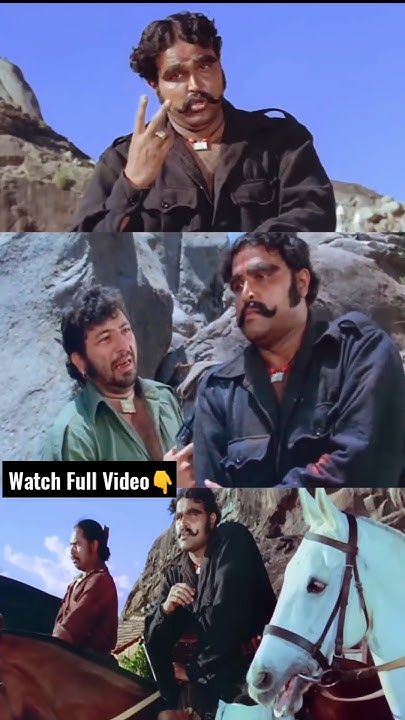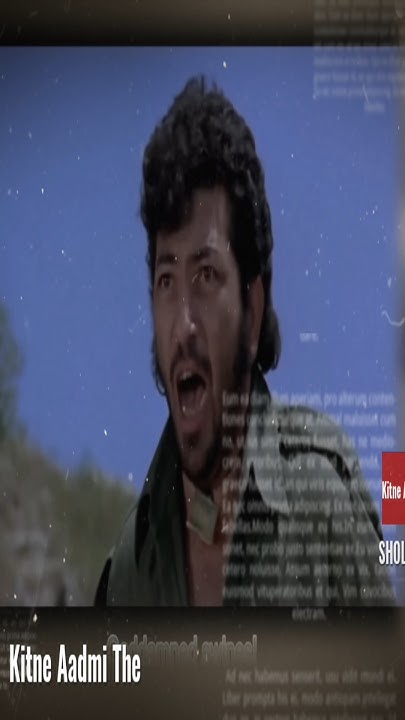Sholay Movie Dialogue Kitne Aadmi The

The iconic dialogue "Kitne Aadmi The" from the 1975 Bollywood blockbuster Sholay continues to resonate deeply with audiences decades after its release. Beyond its simple construction, the phrase has permeated Indian popular culture, finding its way into everyday conversations, political commentary, and advertising campaigns.
The "Kitne Aadmi The" dialogue, delivered by the menacing villain Gabbar Singh, encapsulates the film's themes of good versus evil and the helplessness of ordinary villagers against overwhelming odds. This article examines the enduring legacy of this dialogue, its cultural impact, and the factors contributing to its lasting appeal.
Sholay, directed by Ramesh Sippy, premiered on August 15, 1975, and initially faced mixed reviews. However, word-of-mouth and subsequent screenings propelled it to become one of the highest-grossing Indian films of all time. The film's characters, including the dacoit Gabbar Singh, played by Amjad Khan, became instantly recognizable.
The Dialogue's Genesis and Delivery
The scene featuring the dialogue takes place in the village of Ramgarh, where Gabbar Singh and his gang terrorize the inhabitants. Thakur Baldev Singh, a retired police officer, hires two ex-convicts, Veeru and Jai, to protect the village.
Gabbar Singh, upon encountering Thakur's men, chillingly asks, "Kitne Aadmi The?" (How many men were there?). The dialogue, delivered with a distinct drawl and a menacing tone by Amjad Khan, immediately established Gabbar as a formidable and ruthless antagonist.
The simplicity of the dialogue is deceiving, its effectiveness amplified by Amjad Khan's masterful performance. The pauses, the intonation, and the sheer menace conveyed through his eyes made the dialogue unforgettable.
Cultural Impact and Enduring Appeal
The "Kitne Aadmi The" dialogue quickly transcended its cinematic origins to become a cultural touchstone. It's frequently used in everyday conversations to mock authority figures or highlight situations where individuals are outnumbered.
The dialogue has been referenced and parodied extensively in Indian cinema, television, and advertising. It's also found its way into political discourse, often used to criticize governmental policies or highlight power imbalances.
The enduring appeal of the dialogue stems from its relatability and its embodiment of classic themes of good versus evil. It represents the struggle against oppression and the courage to stand up against overwhelming odds.
The Power of Simplicity
Despite its simple structure, the dialogue's impact is undeniable. Its conciseness and directness make it instantly memorable and easily adaptable to various contexts.
The dialogue also taps into a primal fear of being outnumbered and outmatched. This fear resonates with audiences across different generations and backgrounds.
The context in which the dialogue is delivered – a scene of impending violence and oppression – further enhances its impact. It’s a stark reminder of the vulnerability of ordinary people in the face of power.
The Legacy of Sholay
Sholay is widely regarded as one of the most influential films in Indian cinema history. The film's success paved the way for numerous action-adventure films and established several actors as superstars.
The film's dialogues, including "Kitne Aadmi The," have become ingrained in the collective memory of Indian audiences. These dialogues continue to be quoted and celebrated, ensuring the film's enduring legacy.
The influence of Sholay can still be seen in contemporary Indian cinema, with many filmmakers drawing inspiration from its characters, themes, and storytelling techniques.
Sholay's enduring popularity is a testament to its timeless appeal and its ability to connect with audiences on a deeper level. The "Kitne Aadmi The" dialogue remains a powerful symbol of the film's impact and its lasting legacy.






![Sholay Movie Dialogue Kitne Aadmi The Sholay movie best dialogue in Bhojpuri. [Kitne aadmi the] - YouTube](https://i.ytimg.com/vi/C5wL3gi4cyo/maxresdefault.jpg)











